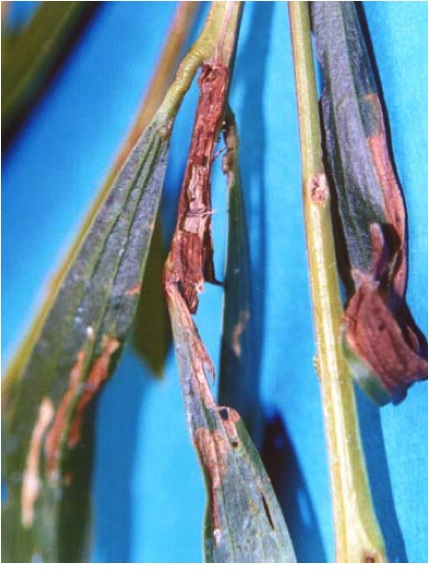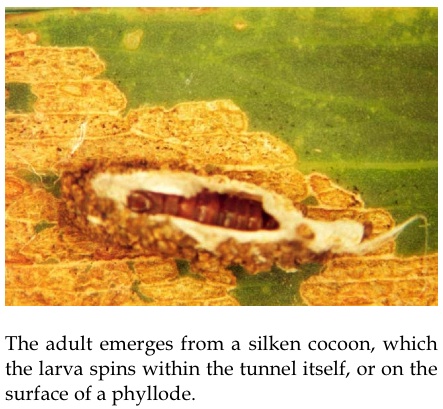PESTS AND DISEASES OF FORESTRY IN NEW ZEALAND
Another Tortricid on Acacia
Scion is the leading provider of forest-related knowledge in New Zealand
Formerly known as the Forest Research Institute, Scion has been a leader in research relating to forest health for over 50 years. The Rotorua-based Crown Research Institute continues to provide science that will protect all forests from damage caused by insect pests, pathogens and weeds. The information presented below arises from these research activities.
From Forest Health News 109, July 2001.
In December, last year, Les Renney (Vigil Forest Health Advisory Services) collected a tortricid caterpillar, believed to be the larva of the eucalypt leafroller (Strepsicrates macropetana), from an Acacia longifolia tree growing at Avondale, Auckland. This moth is widespread throughout the country, and causes damage to the foliage of a number of eucalypts. However, closer examination showed that a different species had been collected. This was confirmed by entomologist John Dugdale (Landcare Research), who identified the Avondale specimen as a distinct, but very similar insect closely related to the Australian species Holocola triangulana . Because it is not exactly the same, the new tortricid is being referred to as Holocola sp. near triangulana , until this complex group is properly studied.
 Strepsicrates (including our native species) and Holocola are closely related. The adults of Strepsicrates macropetana and the new Holocola sp. are very similar and the larvae virtually indistinguishable, apart from a slightly incomplete darkened 'U' pattern on the anal shield of the latter.
Strepsicrates (including our native species) and Holocola are closely related. The adults of Strepsicrates macropetana and the new Holocola sp. are very similar and the larvae virtually indistinguishable, apart from a slightly incomplete darkened 'U' pattern on the anal shield of the latter.
Since becoming aware of this insect, Vigil staff have made further collections of Holocola sp. in the Wanganui bioregion (Ohakea, Wanganui), and there are unconfirmed reports from the Bay of Plenty and Coromandel bioregions. The insect was first found in Nelson by John Dugdale in 1989, and lepidopterist Robert Hoare (Landcare Research) has worked with it more recently. John Dugdale believes this moth may have been carried naturally to New Zealand by means of trans-Tasman air currents.
Evidence so far indicates that Holocola sp. feeds only on Acacia longifolia . An examination of the published literature suggests that species of Holocola feed within the galls caused by rust fungi on certain acacias. However, the introduced Holocola sp. appears to behave differently. Some larvae tie the acacia phyllodes1 together and eat the enclosed tissues, producing a characteristic gouging pattern, while others bore into the elongating soft shoots. My own observations suggest that the larva periodically leaves its tunnel in order to feed, causing a brown-coloured window effect on the damaged phyllodes. Acacia longifolia is a comparatively small tree, and when attacked develops a general browning appearance across the crown.
 The adult emerges from a silken cocoon, which the larva spins within the tunnel itself, or on the surface of a phyllode.
The adult emerges from a silken cocoon, which the larva spins within the tunnel itself, or on the surface of a phyllode.
Acacia longifolia is a significant weed in a number of Pinus radiata forests in Northland. Some forestry companies in this region are hopeful that Holocola sp. near triangulana will continue to spread and thrive, and perhaps even act as a naturally introduced biological control agent of a troublesome weed.
Toni Withers, Forest Research
This information is intended for general interest only. It is not intended to be a substitute for specific specialist advice on any matter and should not be relied on for that purpose. Scion will not be liable for any direct, indirect, incidental, special, consequential or exemplary damages, loss of profits, or any other intangible losses that result from using the information provided on this site.
(Scion is the trading name of the New Zealand Forest Research Institute Limited.)

 Farm Forestry New Zealand
Farm Forestry New Zealand

